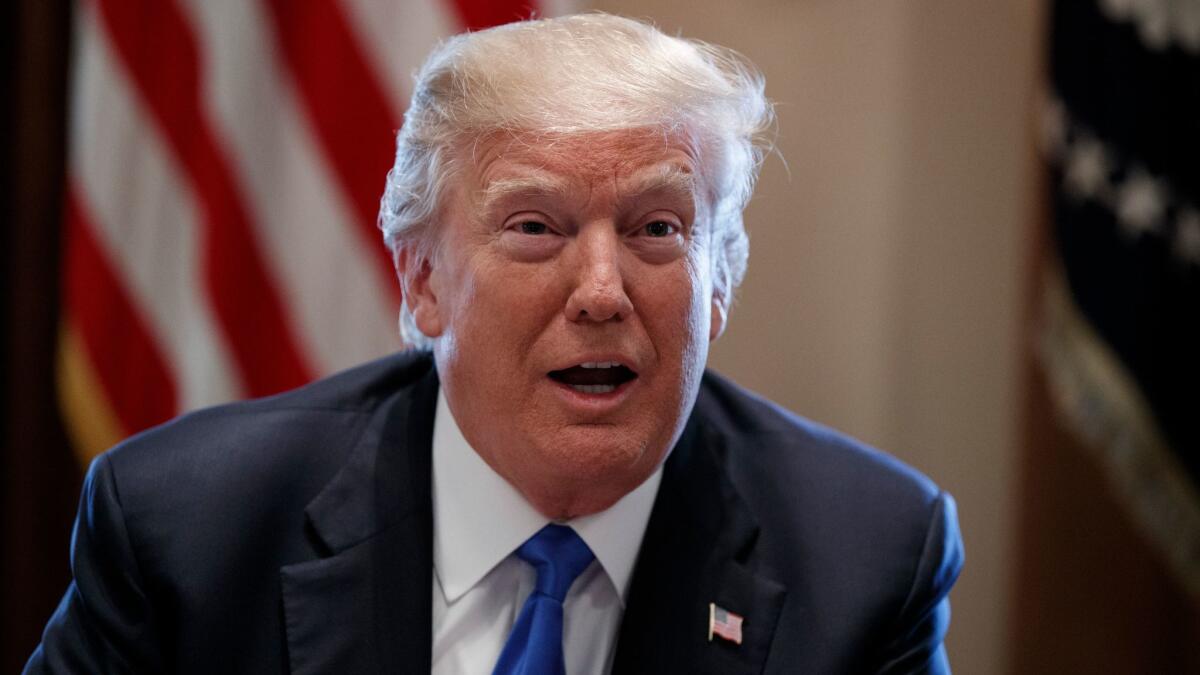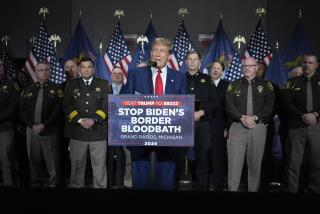Trump wants to kill two immigration programs, but doesn’t seem to know how they work

As television cameras were allowed to roll during a lengthy immigration meeting at the White House last week, President Trump groused to lawmakers about how 50,000 people each year get coveted green cards through a visa program he wants to kill.
Countries “put names in a hopper,” Trump said. Then American officials “put their hand in a bowl” and draw out the “worst of the worst.”
One problem: That’s not how it works. Nor is Trump accurate when he describes a second immigration program, which he calls “chain migration” but which advocates describe as family reunification. Yet he wants both killed as a condition for backing a popular third program — the so-called DACA permits for hundreds of thousands of immigrants who came to the United States illegally as children.
Contrary to Trump’s repeated claims, the visa lottery has no bowl, no hopper. The State Department runs a computerized drawing from entries each year. Countries don’t submit names, individuals do. To diversify the immigrant pool, foreign nationals from countries with low numbers of immigrants to the U.S. are allowed to enter the lottery — hence the name, Diversity Visa Lottery Program.
Entrants must have a high school education or have worked for two years in a skilled job. Their names are vetted and checked against crime and terrorism databases. Each of the 50,000 lottery winners annually is interviewed at a local U.S. consulate before being allowed to enter the country.
Trump has repeatedly cited terrorism threats as a reason to end both the visa lottery and the so-called chain migration program, which allows citizens to sponsor close relatives to migrate to the U.S. But his administration has struggled to make a link.
“There is simply nothing about either of these two programs that presents any specific risk of terrorism,” said Stephen H. Legomsky, professor emeritus of immigration law at Washington University School of Law and former chief counsel for immigration services at the Homeland Security Department from 2011 to 2013.
“These immigrants are vetted for terrorist possibilities just as thoroughly as all immigrants.”
Trump’s focus on the visa lottery began Nov. 1, with a tweet connecting it to the previous day’s Halloween terrorist attack in New York, where a driver plowed a rented pickup through a crowded bike lane, killing eight people.
Sayfullo Saipov, 29, who came to the U.S. from Uzbekistan through the Diversity Visa Lottery Program in 2010, has been charged in the attack. But the Trump administration has not explained how immigration agents could know someone like Saipov would plot an attack years after entering the country.
Trump has also linked Saipov to the supposed dangers of allowing recent migrants to sponsor relatives. In an interview with Fox News host Laura Ingraham in November, Trump claimed Saipov brought in 23 relatives. That cannot be true given that immigration law allows green-card holders to sponsor only a spouse and minor children.
“CHAIN MIGRATION must end now! Some people come in, and they bring their whole family with them, who can be truly evil,” Trump wrote on Twitter the day after Saipov’s attack.
While family unification has been a feature of immigration law for years, last month Trump included “chain migration” as a security threat in his National Security Strategy.
This week, the administration stepped up its case against the two programs. On Wednesday, the White House had Ed O’Callaghan, the head of the Justice Department’s national security division, brief reporters on a new department paper that links terrorism with migration as evidence of the need to reshape the nation’s immigration system.
The report, which Trump ordered last year, said that 75% of the 549 people convicted of terrorism charges since Sept. 11, 2001, were born outside the United States. Callaghan, echoing the president, called for scrapping the policy of family preferences for visas, as well as the visa lottery program.
He pointed to the case of Uzair Paracha, a Pakistan-born businessman who came to the U.S. around 1980 as part of the family of a legal, permanent resident, and was convicted 25 years later, in 2005, of aiding Al Qaeda.
The report did not specify how many — if any — of those convicted since Sept. 11 entered the country through the lottery or family unification programs. It also did not detail whether the convictions were related to attacks or planned attacks in the U.S. or at overseas locations. Those details were not available, officials said.
The visa lottery is the only way that a foreign citizen can settle in the United States without having a close American relative or a job with a U.S. company that requires special skills, or qualifying as a refugee from a humanitarian crisis.
In past tweets, Trump has called the program the “Democrat Lottery Systems” and a “beauty” contrived by Sen. Charles E. Schumer of New York, the Senate Democratic leader. Again, he’s wrong. The program, which took effect in 1995, was created as part of a broader law signed by President George H.W. Bush in 1990. It was designed to address concerns by Irish American and Italian American groups that distant relatives didn’t have a way to legally immigrate.
The lottery’s 50,000 slots are about 5% of the 1 million people given lawful permanent residence, or green cards, each year.
In 2015, the largest share of lottery entrants were Africans, who accounted for 43%; 32% were Europeans, 19% Asians, 3% Latin Americans, and less than 1% were people from Pacific island nations.
About 60% of immigrants coming legally to the U.S. arrive because of a close family connection. Green-card holders can sponsor minor children and spouses for permanent residency. U.S. citizens can request green cards for married children and parents, but those categories are limited to 23,400 married children and 67,500 adult siblings each year. The wait for those slots can be more than a decade.
Times staff writer Joseph Tanfani in Washington contributed to this report.
Twitter: @ByBrianBennett
More to Read
Get the L.A. Times Politics newsletter
Deeply reported insights into legislation, politics and policy from Sacramento, Washington and beyond. In your inbox three times per week.
You may occasionally receive promotional content from the Los Angeles Times.







